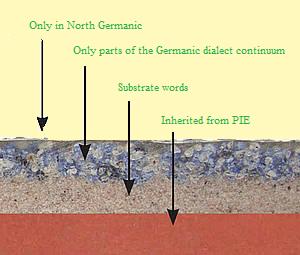At the research centre Roots of Europe – Language, Culture, and Migrations the majority of scholars dealing with the first of the three branches, language, is concerned mainly with morphology. Within this field of study, focus mainly lies with nominal word formation: Birgit Anette Olsen on Proto-Indo-European, Benedicte Nielsen Whitehead on Latin, Anders Richardt Jørgensen on British Celtic, Jenny Larsson (within the first year of the project period) on Baltic and myself on Germanic and Old Norse.
Seen from the outside, one might rightfully question the relevance of morphological studies to the study of how these “native” languages of Europe were established within their cultural and social context, as stated in the aims and goals section of the Roots of Europe general project description.
Nevertheless, one need not search too far in order to find an immediate response to such a critique. Several of the individual subprojects suggest or at least hint at the possibility that systematic categorisation of the noun-forming suffixes in the individual linguistic branches of Indo-European can provide answers to questions as those stated in the preceding paragraph if such a categorisation be carried out by theoretical analysis of the relevant material according to, mainly, the comparative method. How fantastic this idea may seem, it is actually quite straightforward: If the comparative method can prove that one or more elements – be they phonemes or morphemes – of a given word in one language correspond systematically to other elements in another language, these elements – and consequently these two languages – must be related to one another and must originate from a common source. In other words, if the comparative method can prove the interrelationship between a noun-forming suffix in one language and a noun-forming suffix in another language, these two noun-forming suffixes must be related to one another and must originate from a common source.
Thus far, scholars of Indo-European linguistics probably have not gained much new insight from reading this blog post. What might be at least partially new, though, is the theory that I present in my article “Rodnominers struktur og produktivitet i germansk” [The structure and productivity of root nouns in Germanic] (to pe published this year in E. Hansen, A. Holsting & H.F. Nielsen, eds. Ældre germansk sproghistorie. Et uformelt minisymposium. Mindre Skrifter 29. Center for Middelalderstudier, Syddansk Universitet, Odense.) and that I will also present in an elaborated form at the 14th international conference of the Society of Indo-European Studies to be held September this year in Copenhagen.
 The basic outline of the theory is that root nouns in Germanic may be divided into four chronological layers according to various morphological and morphonological criteria. One of these layers consists of root nouns inherited from Proto-Indo-European and subject to paradigmatic levelling of Ablaut according to the phonotactic attributes of the root, while substrate root nouns such as those introduced – and phonotactically and morphologically defined – by Guus Kroonen’s forthcoming article “Non-Indo-European Root Nouns in Germanic: Evidence in Support of the Agricultural Substrate Hypothesis” (to be published this year in R. Grünthal & P. Kallio, eds. Linguistic Map of Prehistoric North Europe. Mémoires de la Société Finno-Ougrienne. Helsinki, Société Finno-Ougrienne) constitutes yet another layer.
The basic outline of the theory is that root nouns in Germanic may be divided into four chronological layers according to various morphological and morphonological criteria. One of these layers consists of root nouns inherited from Proto-Indo-European and subject to paradigmatic levelling of Ablaut according to the phonotactic attributes of the root, while substrate root nouns such as those introduced – and phonotactically and morphologically defined – by Guus Kroonen’s forthcoming article “Non-Indo-European Root Nouns in Germanic: Evidence in Support of the Agricultural Substrate Hypothesis” (to be published this year in R. Grünthal & P. Kallio, eds. Linguistic Map of Prehistoric North Europe. Mémoires de la Société Finno-Ougrienne. Helsinki, Société Finno-Ougrienne) constitutes yet another layer.
Generally, I expect lexical ‘layering models’ based on criteria similar or identical to the ones in my forthcoming article to be particularly valuable for palaeolinguistic analysis. The reason is that such layering models may reveal what parts of the Germanic lexicon had already been adapted at the Pre- or early Proto-Germanic stage from other sub-, super- or adstrate languages; what parts are of common Indo-European origin; what parts belong to only a restricted part of the Germanic-speaking area and what parts may be later cultural loans from known or unknown sources.
Consequently, I believe that this ‘layering model’ of Germanic root nouns constitutes a brilliant example of one of the hallmarks of the Roots of Europe centre, viz. the aim of producing apparent models on how morphological analysis may produce knowledge on ancient societies.
